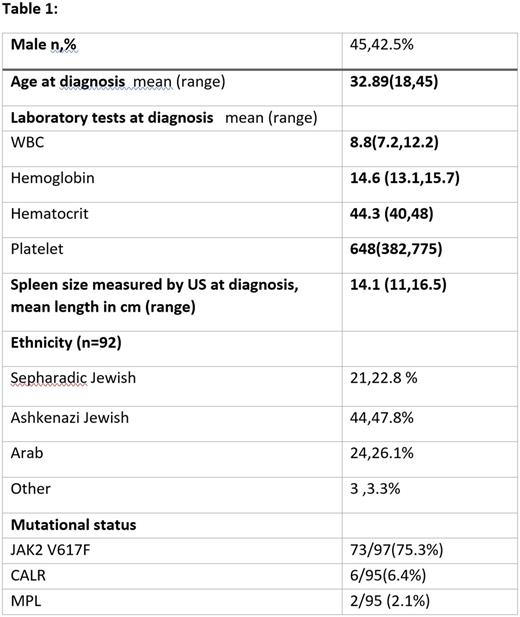Abstract
Introduction: Age is an adverse prognostic factor in Ph-negative MPNs. Most MPN patients are diagnosed in their sixth decade, which may affect their ability to cope with disease symptoms and treatment and thus worsen their outcome. In contrast, in younger patients other challenges such as long term treatment side effects, prevention of disease progression and fertility issues are more prominent. The current study investigates the characteristics and outcome of Ph-negative MPN patients younger than 45 years.
Methods: A retrospective study,evaluating patients 18-45 years of age at the time of diagnosis of Ph-negative MPN, between 1985-2017. Primary outcomes were mortality, transformation to secondary myelofibrosis (MF), transformation to acute myeloid leukemia (AML) and undergoing an allogeneic stem cell transplantation (alloSCT). Secondary outcomes were thrombotic events and pregnancy complications. Risk factors for the composite outcome of venous and arterial thrombosis and for the composite outcome of transformation to MF,AML or undergoing AlloSCT were determined by multivariate analysis.
Results: 106 patients were included. The median follow-up time was 8 years (range 5 months to 32 years). Diagnosis at presentation was polycythemia vera (PV) (34,32%), essential thrombocytosis (ET) (50,47%), primary MF (15,14%), early MF(4,4%)and MPN not otherwise specified (NOS) (3,3%). Patient baseline characteristics are presented in table 1.
At diagnosis, 37 patients (35%) were treated with hydroxyurea,10(10%) with another cyto-reductivetherapy (Interferon,anagrelide,ruxolitinib) and 54(55%) did not receive any cyto-reductive therapy.
Within a median follow up of 8 years, 10 patients developed secondary MF (9.4%) ,2 patients developed AML (2%) and 7 patients underwent alloSCT (6.6%).7patients have died (6.6%); 1 due to transformation to AML, 3 due to MF -related complications ,2 due to alloSCT complications and 1 due to sudden death. The only significant risk factor for the composite outcome of transformation to MF, AML or alloSCT was diagnosis of MF at presentation (P=0.05).
There were 37(35%) thrombotic events, mostly venous (29 events).Thrombotic events were most frequent in ET patients (16,43%), followed by PV (12,32%), MF (7,19%),early MF(1,3%) and MPD NOS(1,3%). Risk factors for composite thrombosis were JAK2 V617 mutation (P=0.052) and splenomegaly (P=0.003).
25 women became pregnant after diagnosis of MPN (46 pregnancies). Spontaneous abortions were documented in 4 pregnancies, fetal malformation in 2(7%) and premature delivery in one(3%).Maternal outcome was uneventful in all pregnant women.
Conclusions: Patients diagnosed with Ph-negative MPN at a young age are at comparable risk as the general population of MPN patients of developing secondary MF but at lower risk of developing AML at a median follow up of 8 years. A diagnosis of MF at presentation predicts a worse prognosis. JAK2 mutation and splenomegaly at presentation are associated with an increased risk for thrombotic events.
No relevant conflicts of interest to declare.
Author notes
Asterisk with author names denotes non-ASH members.


This feature is available to Subscribers Only
Sign In or Create an Account Close Modal